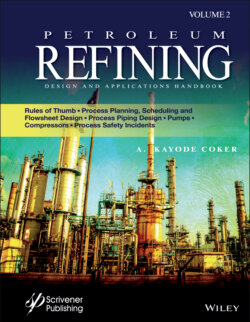Читать книгу Petroleum Refining Design and Applications Handbook - A. Kayode Coker - Страница 38
UTILITIES, COMMON SPECIFICATIONS
Оглавление1 1. Steam: 1–2 bar (15–30 psig), 121–135°C (250–275°F); 10 barg (150 psig), 186°C (366°F); 27.6 barg (400 psig), 231°C (448°F); 41.3 barg (600 psig), 252°C (488°F) or with 55–85°C (100–150°F) superheat.
2 2. Cooling water: For design of cooling tower use, supply at 27–32°C (80–90°F); from cooling tower, return at 45–52°C (115–125°F); return seawater at 43°C (110°F); return tempered water or steam condensate above 52°C (125°F).
3 3. Cooling air supply at 29–35°C (85–95°F); temperature approach to process, 22°C (40°F).
4 4. Compressed air at 3.1 (45), 10.3 (150), 20.6 (300), or 30.9 barg (450 psig) levels.
5 5. Instrument air at 3.1 barg (45 psig), −18°C (0°F) dew point.
6 6. Fuels: gas of 37,200 kJ/m3 (1000 Btu/SCF) at 0.35–0.69 barg (5–10 psig), or up to 1.73 barg (25 psig) for some types of burners; liquid at 39.8 GJ/m3 (6 million British Thermal unit per barrel).
7 7. Heat-transfer fluids: petroleum oils below 315°C (600°F) Dowtherms below 400°C (750°F), fused salts below 600°C (1100°F), and direct fire or electricity above 232°C (450°F).
8 8. Electricity: 0.75–74.7 kW (1–100 hp), 220–550 V; 149–1864 kW (200–2500 hp), 2300–4000 V.
